



Highlights of ELAC Senate / House Committee Testimony January 2017 • Indiana is home to roughly 168,000 preschool children aged 3 and 4. That means there are about 84,000 pre-k children – those at 4 years of age. • About two-thirds of those children (66%) NEED care from other adults, because their parents are part of Indiana’s workforce. • That means about 111,000 of Indiana’s 168,000 3 and 4 year olds NEED care because their parents work…but only 91,000 of these kids are in known care…a formal setting licensed or registered by the state. The rest – the other 20,000 – are being cared for in an informal setting – cared for by a family, friend, or neighbor. • Indiana offers a mixed-delivery system – with multiple types of formal providers. Although the largest number of providers are family child care, they typically take care of just a few children. Centers and public schools tend to have larger number of kids attending. • But it’s not enough for kids just to be in a formal setting - in order for pre-K investments to make a difference, kids need to be in a setting that is rated high-quality. • Statewide, only 30,000 (27%) of the preschool kids who need care are getting what IN considers to be a high quality educational experience. • Access to a high quality education varies tremendously by county, with 9 counties having no access to high quality programs. • So if high quality is key to delivering results, 2 things are needed – a quality early education experience needs to be more accessible and it needs to be more affordable. • Increased access to high-quality requires Indiana to invest in more seats (classrooms) – and more staff (credentialed coached, and compensated teachers). • In terms of affordability, on average, it costs $7,800 per year for one preschooler to attend a high quality program. • Families in poverty would have to dedicate over 40% of their income to pay for a high quality provider. • Federal and state dollars already are used in Indiana to assist some of the poorest families. But the vast majority (2/3) of the $1.3 billion spent each year on Indiana’s early education, is paid for by families themselves. • Roughly 12,000 of Indiana’s poorest 84,000 4 year olds are being served by federal programs (Head Start; CCDF) or state pilots (EEMG, On My Way). However, that means tens of thousands of 4 year olds (at or slightly above poverty levels) receive no subsidies to make care affordable. • Research shows that state pilots ARE effectively delivering positive outcomes for children (kindergarten readiness academically and socially) AND their families (more work hours; better jobs; additional education).
Senate / House Committee Presentation January 2017 Annual Needs Assessment http://www.elacindiana.org INDIANA EARLY LEARNING ADVISORY COMMITTEE SENATE / HOUSE COMMITTEE PRESENTATION JANUARY 2017 Hoosier Young Children Preschool Children Early Learning Advisory Committee 1
Senate / House Committee Presentation January 2017 Enrollment by Program Type Indiana’s High Quality Rating System High-Quality Preschool Children in High Quality Programs Early Learning Advisory Committee 2
Senate / House Committee Presentation January 2017 High Quality Pre-K will be Accessible Build Capacity Seats Accessible for all Affordable for at-risk children and families families Staff Accessible Affordable ESTIMATED HIGH-QUALITY SLOT COSTS BY DOSAGE AND DELIVERY MODEL Staff with: (STATE PROVIDER LEVEL COSTS) • C redentials • C oaching C onsistency (retention) • Early Learning Advisory Committee 3
Senate / House Committee Presentation January 2017 Affordable Affordable $24,300 $30,375 $44,955 $48,600 UNSERVED PREKINDERGARTENERS IN HIGH QUALITY SUBSIDIZED CARE Affordable INDIANA’S EARLY LEARNING FUNDING SOURCES The largest source (65%) of early learning funding is private – which means directly from the families’ own income. Early Learning Advisory Committee 4
Senate / House Committee Presentation January 2017 Pilot Results Pilot Results • Children made substantial gains in kindergarten readiness, overcoming delays and decreasing at-risk behaviors. • Children outpace the comparison group on language comprehension, early literacy skills, executive functioning and social skills. • Positive impact on families including improved earnings and/or education for parents. • Of the children enrolled in OMW programs, 34% would be at home if not for the OMW program. • Families of children enrolled in OMW programs report that they increased work or school hours (51%), were able to get a new job (35%), or began school or job training (33%). Questions Kevin Bain, Chairman of ELAC CEO and Executive Director, Welborn Baptist Foundation Early Learning Advisory Committee 5
Recommend
More recommend